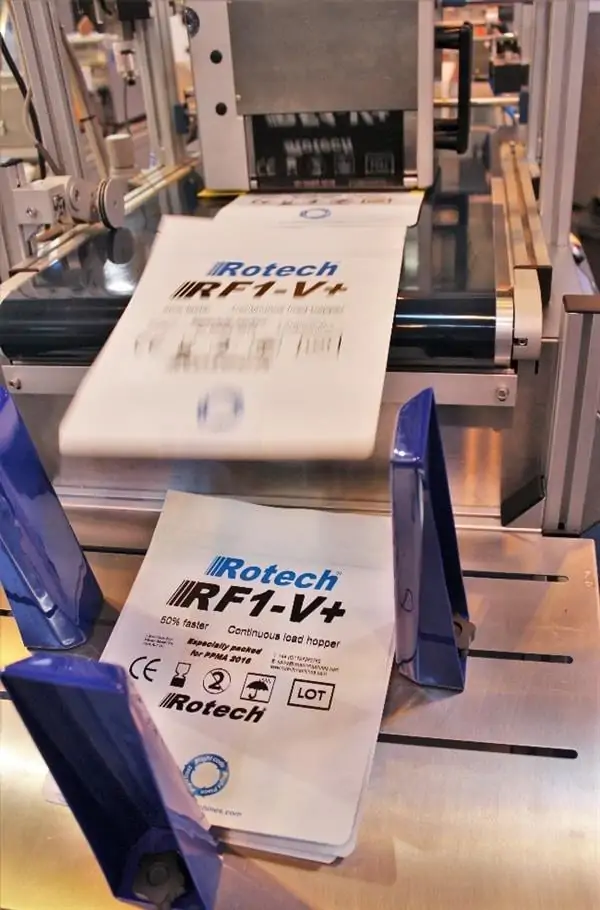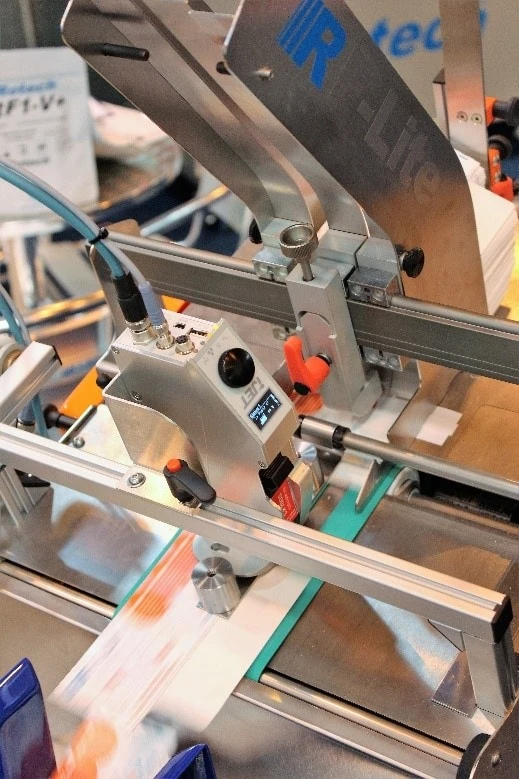The terms ‘contact’ and ‘contact-free’ are often used in relation to industrial coding, but what do they actually mean and why does it matter whether a coder is contact-free or not? Richard Pether, director at coding and marking specialist Rotech, discusses the suitability of each method in a number of commonly encountered coding scenarios.
Thermal inkjet (TIJ), continuous inkjet (CIJ) and laser coding are all non-contact coding techniques, whilst thermal transfer is the contact coding method of choice.
The distinction between contact and contact-less coding has to do with the way the ink is transferred onto the substrate. With CIJ and TIJ, ink drops are forced out of nozzles through pressure, so the ink is effectively ‘thrown’ at the substrate. With CIJ the high velocity of the ink droplets allows for a long throw distance of up to 10mm between printhead and substrate. TIJ has a shorter throw distance than CIJ – for optimum performance, substrates need to be less than 2mm away from the print head.
Contact thermal transfer marking works through heat being transmitted onto a ribbon (a tape coated with specially designed ink). The ribbon then transfers the image to the label. To enable the printhead to touch the packaging substrate, units must be installed directly onto a packaging machine or labelling system.
But how do you know whether to go for a contact or a contact-free coding method?
SCENARIO 1: LATE STAGE CUSTOMISATION
There is a growing trend towards late stage customisation, for example, buying in pre-branded packs and overprinting variable information such as product descriptions, ingredient lists, bar codes, date codes and batch codes on-line and on demand. Where that information is static, old school analogue hot stamp coding may offer sufficient functionality. However, the majority of today’s producers want the flexibility to print codes that are unique to every package, bringing digital methods to the fore. Where a large print area is needed, thermal transfer is the technology of choice as it is available with print widths of up to eight inches. In general, contact-less coding techniques are designed to apply small amounts of information, although there are also large format inkjet printers that will print onto the side of a box.
SCENARIO 2: SMALL AMOUNTS OF DATA
Usually, a contact-less technology will be more cost-effective for printing small amounts of information, such as date and batch codes. It is in these applications that TIJ printers come into their own as they are clean, compact and easy to use – the simple cartridge system combines both a printhead and ink supply system. With thermal transfer, the larger print head size coupled with the cost of ribbons and inks makes it an unattractive option. However, the type of substrate also comes into play here, and non-porous or glossy surfaces such as films may be best printed with a contact method.
SCENARIO 3: SUBSTRATES OF VARYING THICKNESSES
The challenge of printing on surfaces of varying thicknesses often arises in pharmaceutical carton applications. Typically, a pharmaceutical manufacturer will want to print lot numbers and date codes on the end flap of a carton as well as some additional information along the body of the pack. Where the two end flaps overlap, this creates a surface that is varying in thickness. Unless the coder can place all of the data on the area of the carton end that is double thickness, a contact coder will not be suitable for this application. TIJ and CIJ, by contrast, can print over seams, folds and different pack sections.
SCENARIO 4: FILLED PACKS
Whilst thermal transfer printers come into their own for coding flexible packaging as it is being formed, when it comes to on-line coding of packs that have already been filled – whether pre-made pouches or cartons – this will invariably be a job for a contact-less coder. Thermal transfer coders struggle to print on anything other than flat film.
SCENARIO 5: MACHINE READABLE CODES
Bar codes and thermal transfer printers go hand in hand. When printing EAN13 bar codes, for example, thermal transfer is widely accepted as producing high quality results. However, when it comes to datamatrix codes, which usually only measure 10 x 10mm, thermal transfer is probably overkill. TIJs place their pixels more accurately and offer higher resolution printing (typically 300 dpi or above) than CIJ systems, making TIJ the obvious print technology of choice for 2D codes.
SCENARIO 6: SHINY SURFACES
Glossy surfaces are not a problem for thermal transfer coders because of the way heat is applied to melt ink to the material. The ink will bond onto the surface, giving a crisp and durable print. Historically, TIJ has been limited by the materials it can code onto – mainly porous and semi porous materials such as card and labels, with smudging occurring on very shiny surfaces. That said, in recent years, developments in ethanol-based ink technology have expanded the range of substrates that can be printed with TIJ. Inks with exceptional adhesion qualities are now available for printing on previously problematic substrates such as polyethylene, POPP, cast PP and polyester/PET.
SCENARIO 7: PRINTING IN COLOUR
When printing on dark surfaces, it may be necessary to print in white or silver to create a contrast between code and background. Thermal transfer allows you to change the ribbon for high contrast, whereas with inkjet, printing in colour – especially white – is not as straightforward and can involve a lot of waste.
These examples set out some general scenarios, but in coding, nothing is static, and advancements in ink and packaging technologies are constantly eliminating barriers. For example, the development of ethanol-based inks and improvements in ink adhesion, blackness and durability are broadening the field of applications for TIJ. As developments unfold, Rotech will draw on its expertise in both contact and contact-less coding technologies to guide its customers towards to the optimum solution for their application.

